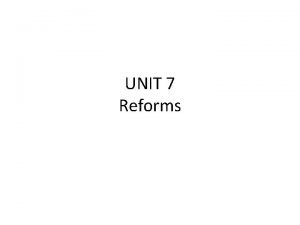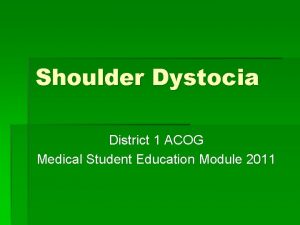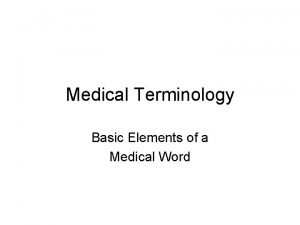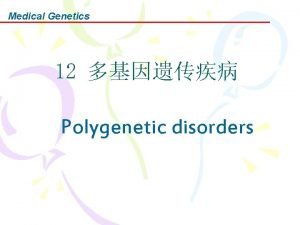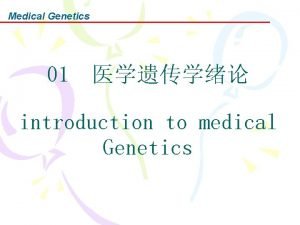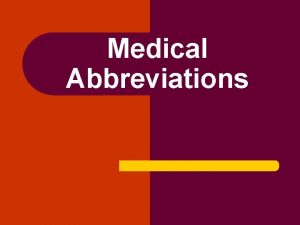Important Teaching Points for Medical Students from THE




































- Slides: 36

Important Teaching Points for Medical Students from: THE ACOG TASK FORCE ON HYPERTENSION IN PREGNANCY

Background on Preeclampsia

Why is preeclampsia important? It can lead to serious maternal and neonatal morbidity Maternal: seizure, stroke, DIC, bleeding, liver hematoma Neonatal: growth restriction, distress/hypoxia in labor, preterm birth It increases a woman’s risk of hypertension and cardiovascular disease later in life

Important points about preeclampsia We don’t know exactly why it happens It occurs only in association with pregnancy ALMOST ALWAYS from 20 wks gestation until delivery RARELY you can see preeclampsia ≤ 6 wks postpartum or before 20 wks gestation It is progressive (worsens as pregnancy progresses) It is multisystemic

What causes preeclampsia? Multifactorial We are not 100% certain of the pathogenesis Gabbe: Obstetrics: Normal and Problem Pregnancies, 6 th ed, Elsevier 2012.

Classification of Hypertension in Pregnancy

Classification of hypertension in pregnancy 1. Preeclampsia-eclampsia 1. Hypertension in association with thrombocytopenia, impaired liver function, the new development of renal insufficiency, pulmonary edema, or new-onset cerebral or visual disturbances 2. Gestational hypertension 1. Blood pressure elevation after 20 weeks of gestation in the absence of proteinuria or the aforementioned systemic findings 3. Chronic hypertension 1. Hypertension that predates pregnancy 4. Superimposed preeclampsia 1. Chronic hypertension in association with preeclampsia

Diagnosis of Preeclampsia

Diagnosis of preeclampsia Blood pressure criteria: SBP ≥ 140 mm Hg or DBP ≥ 90 mm Hg Persistent for 4 hours (repeat blood pressure after at least 4 hours) Plus one or both of the following: Proteinuria �≥ 300 mg protein or more in 24 hour urine collection OR �Urine protein: creatinine ratio of ≥ 0. 3 mg/d. L OR � 1+ protein on urine dipstick (not preferred method) Systemic findings �Thrombocytopenia �Renal insufficiency �Impaired liver function �Pulmonary edema �Cerebral or visual findings

Diagnosis of preeclampsia

Diagnosis of preeclampsia Notice that proteinuria is no longer a necessary part of the diagnosis Waiting to diagnose proteinuria can delay necessary treatment The amount of proteinuria does not predict maternal or fetal outcome

Diagnosis of preeclampsia with severe features

Diagnosis of preeclampsia with severe features HELLP syndrome is a form of “preeclampsia with severe features” (previously known as severe preeclampsia)

Prediction and prevention

Prediction of preeclampsia Screening beyond obtaining an appropriate medical history to evaluate for risk factors is NOT recommended

Risk factors for preeclampsia Gabbe: Obstetrics: Normal and Problem Pregnancies, 6 th ed, Elsevier 2012

Prevention of preeclampsia For women with: A medical history of early onset preeclampsia and preterm delivery at less than 34 0/7 weeks gestation, or Preeclampsia in more than one prior pregnancy Give them low dose aspirin (81 mg) daily beginning in the late first trimester Dietary modifications do not work Bedrest does not work

Management: Gestational Hypertension

Management of gestational hypertension Management is expectant Daily fetal kick counts Twice weekly blood pressure measurements Check for proteinuria at every office visit (urine dipstick) Oral anti-hypertensives are not needed, unless SBP >160 mm. Hb and DBP >110 mm. Hg persistently If they develop preeclampsia, the management changes

Management: Preeclampsia

Management of preeclampsia For preeclampsia WITHOUT severe features (formerly known as mild preeclampsia), manage patients expectantly until 37 0/7 weeks: Daily fetal kick counts Twice weekly blood pressure measurement Weekly labs (platelets, AST, ALT) Do not give antihypertensive medications as long as pressures remain SBP <160 mm. Hb and DBP <110 mm. Hg Monitor fetal growth with monthly ultrasounds �If fetal growth restriction is found, perform umbilical artery Dopplers Delivery is recommended at 37 0/7 weeks When they are being delivered, they probably don’t need magnesium sulfate for seizure prevention If they develop severe features, the management changes

Management of Preeclampsia with Severe Features

Management of preeclampsia with severe features From 24 0/7 wks- 34 0/7 wks you can manage them expectantly: At a tertiary hospital (transfer if necessary) Give BTMZ for fetal lung maturity Treat with antihypertensive medications for sustained SBP ≥ 160 or DBP ≥ 110 A change in the amount of proteinuria should not affect management or dictate delivery

Management of preeclampsia with severe features From 24 0/7 -34 0/7 weeks (continued): If a patient is sick but stable, you can administer BTMZ and wait ≥ 48 hours However, if a patient is unstable or has any of the following, give BTMZ and deliver them immediately: Severe HTN not controlled by IV medications Eclampsia Pulmonary edema Placental abruption DIC Nonreassuring fetal status Fetal demise

Management of preeclampsia with severe features Before 24 0/7 weeks (ie before viability), deliver them immediately The baby will likely not survive

Management of preeclampsia with severe features Delivery is recommended at 34 0/7 weeks Always give magnesium sulfate for seizure prophylaxis

Chronic hypertension (c. HTN) Chronic hypertension with superimposed preeclampsia is managed the same as preeclampsia If severe features develop, it is managed the same as preeclampsia with severe features

Management summary Gestational hypertension Preeclampsia with severe features Chronic hypertension Delivery At the onset of labor 37 0/7 wks 34 0/7 wks 38 0/7 wks Magnesium sulfate No Maybe Yes No BTMZ Only if delivery <34 wks for another indication Yes Only if delivery <34 wks for another indication Inpatient monitoring at tertiary hospital No No Yes No PO antihypertensives Only if >160/110 persistently No Only if >160/110 persistently

Management: simplified High blood pressure in pregnancy Onset <20 wks gestation Onset >20 wks gestation Chronic hypertension Delivery at 38 0/7 wks Pt develops superimposed preeclampsia Delivery at 37 0/7 wks Pt develops superimposed preeclampsia with severe features Gestational hypertension Preeclampsia Deliver when pt is in labor Deliver at 37 0/7 wks Stable patient Unstable patient Inpatient monitoring. Delivery at 34 0/7 wks. Delivery ASAP after BTMZ Preeclampsia with severe features Stable patient Unstable patient Inpatient monitoring. Delivery at 34 0/7 wks Delivery ASAP after BTMZ

Delivery recommendations

Delivery recommendations Induction of labor is acceptable as long as maternal and fetal conditions are stable Epidural and spinal anesthesia are acceptable as long as maternal and fetal conditions are stable Magnesium sulfate seizure prophylaxis is recommended for: Eclampsia Preeclampsia with severe features It can be considered in non-severe preeclampsia

Postpartum

Postpartum recommendations Women with eclampsia and preeclampsia with severe features should get magnesium sulfate seizure prophylaxis for 24 hours postpartum Blood pressures should be monitored postpartum inpatient for at least 72 hours If postpartum blood pressures are persistently ≥ 160/≥ 110, oral antihypertensives should be started Any woman who presents within 6 weeks postpartum with new-onset hypertension with severe features, consider administering magnesium sulfate

Later in life

Later in life For women with a history of: Preeclampsia who gave birth at less than 37 0/7 weeks Recurrent preeclampsia They should have a yearly assessment of: Blood pressure Lipids Fasting blood glucose BMI

Source Roberts, JR et al. “Executive Summary. ” Hypertension in Pregnancy. The ACOG Task Force on Hypertension in Pregnancy. American Congress of Obstetricians and Gynecologists, 2013. Pages 1 -11.
 Champion of filipino students rizal
Champion of filipino students rizal Straddle positioning example
Straddle positioning example Point of difference and point of parity
Point of difference and point of parity Walkthrough of the parts of the entire work immersion
Walkthrough of the parts of the entire work immersion Salamanca statement
Salamanca statement Activism period
Activism period How to avoid foolish opinions by bertrand russell pdf
How to avoid foolish opinions by bertrand russell pdf Why is conduction important
Why is conduction important Communication important points
Communication important points 1916 lucknow pact
1916 lucknow pact From most important to least important in writing
From most important to least important in writing Inverted pyramid in news writing
Inverted pyramid in news writing Least important to most important
Least important to most important Relational mindset
Relational mindset Survivors teaching students
Survivors teaching students Teaching at risk students
Teaching at risk students Web design projects for high school students
Web design projects for high school students Shot put teaching points
Shot put teaching points Strengths and weaknesses of assure model
Strengths and weaknesses of assure model Micro teaching definition
Micro teaching definition Helper in shoulder dystocia
Helper in shoulder dystocia Definition of health psychology
Definition of health psychology Pathology lectures for medical students
Pathology lectures for medical students What are the important elements of medical terms?
What are the important elements of medical terms? Fspos vägledning för kontinuitetshantering
Fspos vägledning för kontinuitetshantering Typiska drag för en novell
Typiska drag för en novell Nationell inriktning för artificiell intelligens
Nationell inriktning för artificiell intelligens Returpilarna
Returpilarna Shingelfrisyren
Shingelfrisyren En lathund för arbete med kontinuitetshantering
En lathund för arbete med kontinuitetshantering Kassaregister ideell förening
Kassaregister ideell förening Personlig tidbok fylla i
Personlig tidbok fylla i Anatomi organ reproduksi
Anatomi organ reproduksi Vad är densitet
Vad är densitet Datorkunskap för nybörjare
Datorkunskap för nybörjare Tack för att ni lyssnade bild
Tack för att ni lyssnade bild Debatt artikel mall
Debatt artikel mall









